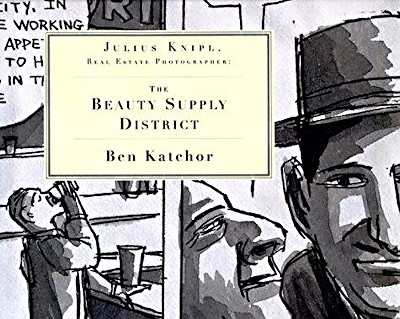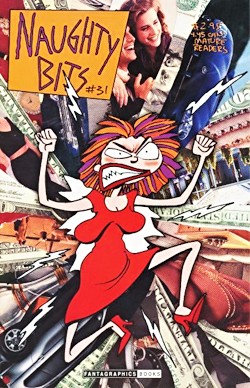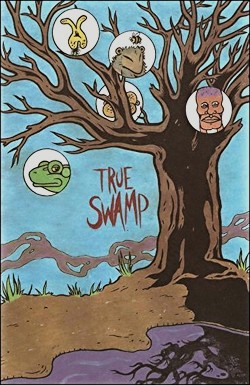“Best Comics 2000”
Por Andrew D. Arnold
Publicado en formato digital por TIME Magazine, viernes 8 de diciembre de 2000.
– – – – – – – – – –
With four different top-tier, trade-published books, the year 2000 has been the best for comics in a very long time.
Best Comic(s) of 2000—a tie:
“Jimmy Corrigan: Smartest Kid on Earth,” by Chris Ware
“Safe Area Gorazde,” by Joe Sacco
These two very different books are both examples of striving for greatness in the comics genre. “Jimmy Corrigan” uses the fictional story of a not-so-bright, aging man to explore themes of family and modern anxiety with dark humor. Chris Ware has the best design sense in comics, using everything from schematic diagrams to 1930s lettering, all at the service of the story and characters.

“Safe Area Gorazde” brings journalism and comics together in an unforgettable portrait of the war in Bosnia. Sacco’s detailed, realistic drawing style provides the pictures that had previously only resided in people’s memories. At last we meet the complicated human beings, whose personal history is really the only one that matters, behind the “Balkan Crisis.”
“Julius Knipl, Real Estate Photographer: The Beauty Supply District,” by Ben Katchor

This third collection of the weekly strip “Julius Knipl: Real Estate Photographer” provides us with the closest thing to comic book poetry around. Katchor has created a romantic urban world where a place like the beauty-supply district consists of businesses that provide detailed recommendations for the beautifying of a customer’s proffered objects. Dreamy, sweet and melancholy, each Knipl strip reads like an ode to a lost world.
“David Boring,” by Daniel Clowes

Sharing similar themes with “Jimmy Corrigan,” “David Boring” features a young man with a vanished father and a clinging mother. But its grayish-blue palette and more conventional layout give it an air of grim seriousness against which take place completely absurd events. (At one point Boring gets shot in the head but merely suffers a dent in his brow.) Clowes has made “David Boring” the most readable comic novel of the year.
America’s Best Comics
As the industry’s only inside outsider, Alan Moore has written the best mainstream books of the last 15 years while maintaining artistic credibility. America’s Best Comics, an imprint of DC Comics, publishes the five most entertaining superhero books on the market: “The League of Extraordinary Gentlemen” (a limited series, now concluded); “Tom Strong,” about a science superman; “Promethea,” starring a mythical warrior princess; “Top Ten,” sort of a “Hill Street Blues” meets the Superfriends; and “Tomorrow Stories,” an anthology title. At least one comes out every two weeks and Moore writes or cowrites them all. So far DC has decided to pulp two issues due to content, so you know he’s doing something right.
“Berlin: City of Stones,” by Jason Lutes

This paperback collects the first eight issues of a projected 25-issue series that takes place in Weimar Berlin. If it reaches completion, this will be the longest, most sophisticated work of historical fiction in the medium. Lutes has a natural, clean, European drawing style, much like Herge’s “Tintin.” This first volume follows a young woman art student who meets a weary leftist journalist against a background of boiling politics and decadence. Only eight issues in, and already this book has the density of the best novels.
NOTA: “Berlin” terminó su publicación en Marzo de 2018, tras 22 tomos. Las recopilaciones “City of Smoke” y “City of Light” completan esta trilogía de comics.
“Louis Riel,” by Chester Brown

How does a history of a real 19th-century Quebecois rebel mystic become fun to read? When he is drawn with the clownish proportions of a tiny head and a giant’s body. Chester Brown makes history his own by rewriting it just slightly, while annotating every altered detail, and presenting it all in his spare, almost goofy drawing style. When the series reaches its end in 2001, it will be collected. Now if only he would finish his version of the Gospels!
NOTA: Publicado por Drawn and Quarterly, “Louis Riel” fue completado tras 10 tomos en el año 2003.
“Naughty Bits,” by Roberta Gregory

Roberta Gregory’s “Naughty Bits” gets props as the only unabashedly female-centric comic currently in existence. Its complex heroine, Midge, flaunts the conventions of what women are allowed to do in comics and other pop-culture media. Midge, aka Bitchy Bitch, is fast approaching 40, hates her pointless desk job, uses “marital aids” without being married, gets very angry very quickly, judges people, and seems to menstruate much more than ordinary. Still, her desire for love and satisfaction make her sympathetic. She has acquired a large enough fan base that you can see her animated adventures on the Oxygen web site.
NOTA: Publicado por Fantagraphics, “Naughty Bits” completó 40 tomos, finalizando en 2004. Oxygen transmitió “Bitchy Bits” como cortometrajes animados en 2001 y posteriormente “Life’s a Bitch” como serie entre 2003-04.
“Luba,” by Gilbert Hernandez

Longtime readers of comics know Luba as a character out of the “Love and Rockets” pantheon, a comic that lasted 15 years until 1990, and is now to be resurrected. In the meantime Gilbert Hernandez has used “Luba” as one of his forums for the cast of characters he created in that pioneering series. Hernandez mixes Latin America with pop-culture America and comes up with an absurdist tele-novella-style work of art. But nicely, while “Luba” has 20 years of backstory, it can still be read as its own work.
NOTA: “Love and Rockets” es una inmensa antología de historias de amor y drama familiar, con más de tres décadas de publicaciones, en diferentes ediciones y formatos. En esta ocasión el autor se refiere a la miniserie de “Luba”, publicada por Fantagraphics entre 1998 y 2004, con una duración de 10 tomos. Hernández continuó la historia del personaje en otra serie de nombre “Luba’s Comics and Stories” (8 tomos entre 2000 y 2006).
“True Swamp: Underwoods and Overtime,” by Jon Lewis

Simply drawn but deeply imaginative, “True Swamp” swallows up all those other anthropomorphic animal comics and leaves them behind in a stinking pile. The hero, Lenny the frog, comes across a mysterious creature in the bog, but soon becomes envious of the attention it gets. This comic exudes a kind of joy and freedom in its seemingly loose, easy-going construction. And what a relief to see animals that are as likely to eat each other as they are to philosophize about the meaning of life.
Worst of 2000:

StanLee.net
Stan Lee, longtime editor and figurehead of Marvel Comics, has gone digital, and come up with exactly the same boring, hackneyed stories and characters he’s been overseeing for the last 30 years. In case you miss the point, the NASDAQ abbreviation (SLEE) is on the homepage. Visit scottmccloud.com for a real vision of the potential of digital comics.
NOTA: ‘NUFF SAID!




